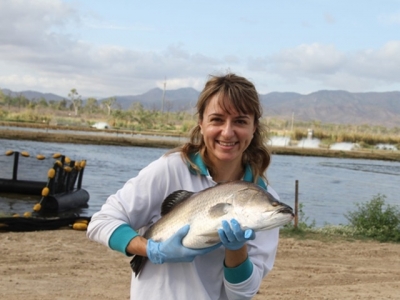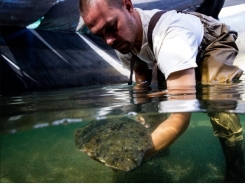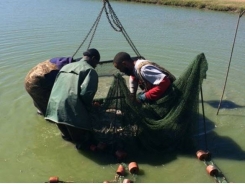Predicting parasite outbreaks in fish farms through environmental DNA

Barramundi case study demonstrates potential of novel tool
The methodology of quantifying environmental DNA from pathogens provides aquaculture production managers and health professionals with a novel and efficient tool to assess the risk of disease outbreaks. Pictured is the lead author.
Diseases are a major impact on, and represent one of the major constraints to future growth of, the aquaculture sector. It has been reported that diseases are responsible for approximately 40 percent of production losses in aquaculture ($102 billion). Therefore, innovative approaches are needed for the early detection and management of disease outbreaks in aquaculture farms. Environmental DNA (eDNA) is a sampling approach associated with molecular techniques that allows the detection of the genetic material of any micro- or macro-organism present in the environment. This technique has the potential to revolutionize the way pathogens are detected and monitored in aquaculture.
Environmental DNA presents an alternative to invasive sampling and quantification of pathogens by collecting water or soil samples from aquaculture systems. While traditional diagnostics (e.g. histopathology, microbiology, PCR) continue to be the gold standard methodologies to confirm the causative agent of infectious diseases in animals, these techniques are time consuming. By the time farmers obtain results from traditional diagnostic tests to control outbreaks. The environmental DNA approach offers the opportunity to improve animal health monitoring by detecting pathogens in aquaculture systems before animals get infected.
Among different pathogens affecting the aquaculture industry, ciliate protozoans are considered some of the most economically important parasites of finfish. Generally, ciliate parasite outbreaks progress rapidly, without any warning, causing mortalities very quickly. Chilodonella hexasticha is a common ciliate parasite found in freshwater finfish systems, which can alternate between parasitic and free-living stages, killing fish within 2-3 days. Using C. hexasticha as model organism, the eDNA methodology was tested to early detect and quantify pathogens in a barramundi or Asian seabass (Lates calcarifer) farm.
Note: This article is adapted and summarized from the original publication (Aquaculture 479, 2017).
Barramundi case study: sampling and laboratory processing
Water samples from eight earthen ponds (~1.4 ha) of a commercial freshwater barramundi farm from Australia were collected monthly over one year. Triplicate 15 mL pond water samples were collected using individual plastic cups and poured into 50 mL centrifuge tubes containing 1.5 mL of sodium acetate (3 M) and 33.5 mL of absolute ethanol for DNA preservation. Samples were stored on ice until processing in the laboratory.
Samples were processed using a direct eDNA precipitation and extraction method where the genetic material was extracted using a CTAB extraction protocol. Ciliate parasite cells from infected barramundi were collected during the same period for species identification and validation of a quantitative PCR (qPCR) assay. The qPCR assay was developed to identify C. hexasticha abundance (copies cell/µl) in water samples based on the species SSU-rDNA gene region. Figure 1 shows a sample collection flow diagram, from water collection on farm to processing in the molecular laboratory.

Fig. 1: Flow diagram (from A to F) of eDNA methodology for water collection from freshwater barramundi (Lates calcarifer) ponds (A) to qPCR analysis (D, E, F) in the molecular laboratory at James Cook University.
Additionally, environmental and biological data monitored on the farm (dissolved oxygen, temperature, rainfall, fish weight and mortalities) were associated with the abundance of C. hexasticha cell copies/µl (eDNA) in water. This relationship between water quality parameters and parasite abundance was tested using the mean maximum water temperature, minimum dissolved oxygen levels and rainfall over a consecutive 5-day period prior to water sampling for each pond. Similarly, the relationship between parasite abundance in water and fish mortality was tested using the mean number of dead fish recorded over the 5-day period following water sampling in each pond.
Analyses were performed through linear regression and correlation to predict fish mortalities observed in the 5 days post water sampling using measured variables (i.e. abundance of C. hexasticha (eDNA), rainfall, dissolved oxygen and water temperature and fish weight) and to evaluate whether any of the observed environmental variables could predict the abundance of C. hexasticha in water samples. Additionally, a principal component analysis (PCA) was used to determine the association between the observed variables and the abundance of parasite cells in pond water.
Results and discussion
This study used an eDNA approach to quantify the abundance of the ciliate parasite C. hexasticha (eDNA) in water from a commercial barramundi farm and investigate its relationship with water quality and production data. A positive association was observed between abundance of C. hexasticha in pond water (eDNA) and fish mortalities (red circle; quadrant I; Fig. 2), which were inversely related to fish weight (quadrant III; Fig. 2) and dissolved oxygen levels (quadrant IV; Fig. 2). This was further confirmed by a positive correlation between abundance of parasite in pond water (eDNA) and fish mortalities but negatively correlated with fish size. Fish mortalities were also strongly and positively correlated with warmer water. In other words, in the studied farm smaller barramundi tended to be particularly affected by high levels of the ciliate parasite in water and mortalities occurred during the rainy and warm season.

Fig. 2: Principal component analysis (PCA), showing relationship among: abundance of C. hexasticha in barramundi farm water (eDNA), fish mortalities, fish weight, rainfall, dissolved oxygen and average temperature for ponds sampled between 2013/14. Mean dissolved oxygen and water temperature were recorded five days prior eDNA collection. Mean fish mortality were recorded five days following eDNA collection.
Interestingly, a synchronicity between abundance of C. hexasticha cells in water (eDNA) and observed fish mortalities five days post sampling was observed (Fig. 3). Samples from months with higher abundance of parasite in water (eDNA) were also months with higher fish mortalities (Fig. 3). The high abundance of C. hexasticha cells in water and fish weights were significant predictors of fish mortalities, while lower rainfall and fish weights were significantly associated with the high abundance of C. hexasticha cells in water.
Environmental DNA showed to be a powerful approach that can be used to predict fish mortalities, especially when associated with environmental parameters recorded on farm. Given the fact that usually severe fish mortalities occur in fish farms without warning, the quantification of parasite DNA from water samples provide production managers and health professionals with a new efficient tool to assess the risk of future disease outbreaks.

Fig. 3: Environmental and biological parameters from a freshwater barramundi farm from Australia collected between 2013/14; Mean (SE) abundance of C. hexasticha in water (eDNA) and mean fish mortality.
While the eDNA approach for pathogen monitoring in aquaculture is a new area of research, its potential is still under-explored in commercial conditions. Environmental DNA approaches can be used as a non-invasive technique for pathogen sampling to minimize stress and improve animal wellbeing in aquaculture enterprises.
Considering that limited knowledge exists on the diversity of microbial communities within aquaculture systems, eDNA represents a new platform for the industry to unleash the secrets under the water. More specifically within the aquaculture animal health sector, eDNA offers the possibility to understand the abundance and co-infections of pathogens in culture systems. Using next-generation and high throughput sequencing techniques, one single assay can be developed to identify the presence and abundance of multiple aquatic communities in farms and hatcheries.
Finally, eDNA can be easily performed on-farm with the use of portable devices and be incorporated into routine monitoring programs as an efficient tool to assess the risk of future disease outbreaks, thus allowing fish farmers to promptly adopt preventative health management and early intervention strategies.
Authors: Giana Bastos Gomes, Ph.D; Kate S. Hutson, Ph.D; Jose S. Domingos, Ph.D; Catherine Chung; Scott Hayward Terrence L. Miller, Ph.D; Prof. Dean R. Jerry, Ph.D
Có thể bạn quan tâm
Phần mềm

Phối trộn thức ăn chăn nuôi

Pha dung dịch thủy canh

Định mức cho tôm ăn

Phối trộn phân bón NPK

Xác định tỷ lệ tôm sống

Chuyển đổi đơn vị phân bón

Xác định công suất sục khí

Chuyển đổi đơn vị tôm

Tính diện tích nhà kính

Tính thể tích ao hồ




 Land-use efficiency study puts aquaculture on a pedestal
Land-use efficiency study puts aquaculture on a pedestal  Evaluating commercial, dietary pre-, pro- and synbiotics in…
Evaluating commercial, dietary pre-, pro- and synbiotics in…